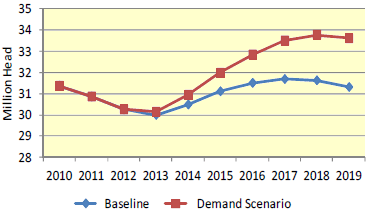



Better Beef Could Mean 10% Hike in Demand
Supply and demand may seem like just concepts from a dusty book. But in today’s cattle market, those fundamentals govern profit and loss, and point toward the future, writes Meghan Blythe for Certified Angus Beef (CAB). “Regardless of the commodity we talk about, the demand for it is going to determine long run supply,” says livestock economist Scott Brown, University of Missouri. He sees potential for significant expansion if more herds produce premium Choice or Prime beef.
Amid a challenging global economy in the last five years, supply and demand highlighted differences within the beef category from the top to low end. Demand for high-quality beef increased more, even as all beef prices rose in response to dwindling supplies. Production input costs continued up, too, but cattle prices climbed to cover costs for most ranchers.
US Beef Cows

“If you would have asked any economist three or four years ago what $7 or $8 corn would have done to this industry, we would have said there wouldn’t have been one,” says Brown. “Well, we are learning that we can feed corn at those prices, but it takes much higher fed-cattle prices than we would have ever thought. So we are seeing the adjustment.”
It’s another example of the fundamentals at work. The squeeze between costs and cattle prices put enough strain on producers over time that many of them reduced their herds or went out of business, steadily reducing the calf supply. So many hard decisions to give up the ranching life eventually pulled prices up for survivors in the industry.
There could be a better way. Brown says a focus on higher quality can make a difference, but it will take time.
“If we all of a sudden provide this better product to consumers, who all the sudden decide, hey, this is a better eating experience, then all of a sudden we shift demand back towards beef,” he muses. Of course, not all of those things can happen “all of a sudden,” but to the extent that they do happen, “then the possibilities are really very large.”
Producing cattle that grade at least USDA Choice is another way to offset some of the high input costs and reduce the risks that tend to drive operators out of business.
“It’s the good news story,” Brown says. “If we could actually grow demand, then we’d have a different way out of the very tough, high-feed-cost environment we’re in today.”
High-quality beef demand’s rise in the recent economic recession suggests a strategy. “Being able to supply a product that isn’t as sensitive to economic changes is one way to reduce risk to producers,” he says. “When the Choice/Select spread narrowed substantially, we saw the Prime/Choice spread stay relatively wide.”
Apparently, the higher the quality beef produced, the brighter ranchers’ future.
“We look at Certified Angus Beef ® and Prime and the very highest end of that quality spectrum, and certainly demand there didn’t seem to lag like it did with some lower quality product,” Brown says.
US Cattle and Calves

The cattle cycle still functions in that declining cow numbers bring higher cattle prices, which provide incentive to expand cowherds. However, if producers shrug off demand for high-quality beef and stick with commodity goals, that recovery may only bring the herd back from 30 million next year to 31.7 million head by 2017. But there could be millions more, perhaps 33.8 million beef cows by 2018, if ranchers rebuild with cattle that produce beef for the high-quality markets.
Brown says, “Providing consumers a product they are demanding, is going to give [producers] a chance to expand the herd that otherwise wouldn’t have been there.”
That approach could mean “a 10% increase in overall demand for beef,” he says, noting that economic models suggest that translates into “a long-term expansion of roughly 6 million head in cattle inventories.”
To summarize without overstating, Brown simply concludes, “It is not insignificant, targeting a beef product that better meets consumer demand today.”
February 2012



